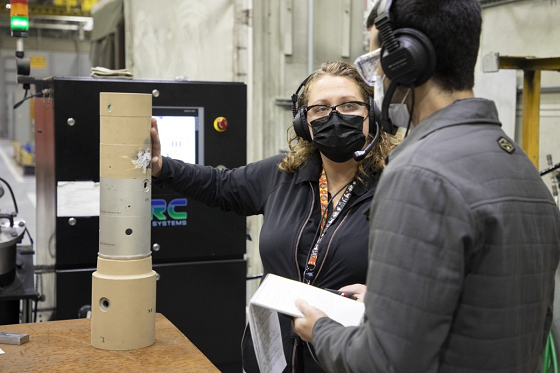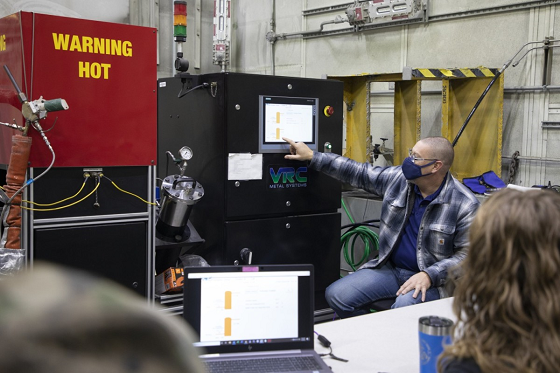Integrating emerging technologies is a critical component of the modernization of the U.S. Army’s Letterkenny Army Depot (LEAD) in Chambersburg, Pennsylvania, USA. According to the Army, LEAD’s modernization plan is designed to provide work lines allowing the depot to sustain readiness, meet Army demands, and posture the depot to maintain future requirements.
“Depot modernization is critical to keep pace with emerging technologies and ensure agility to meet requirements at the time of need,” says Kate Williams, director of the office of strategic management and oversight for the depot’s modernization plan. “LEAD’s modernization team formed in 2019 and comprises experts from across the depot. They developed a plan that integrates the workforce, equipment, facilities and technologies to support enduring and future systems.”
One such technology is cold spray. Depot personnel have been hard at work to bring this technology to LEAD—a process that required collaboration across directorates and thorough safety considerations.
“Cold spray is an additive manufacturing technology that we’re using to repair parts,” says Ashley Filling, a production engineer at LEAD. “Unlike other additive manufacturing technologies that are used to make parts, cold spray is used to repair many different materials. We’re focusing on aluminum right now but are looking to expand into steel repairs as well.”
Cold Spray’s Current Use
Artisans at Letterkenny are using cold spray technology to perform non-structural repairs, including repairs of corrosion and other surface defects. Cold spray offers additional repair benefits because of the lower operating temperature.
“What’s great about cold spray is that you can build up a surface and repair the part without putting a ton of heat on the part,” Filling says. “Right now, for example, we’re looking at parts that have plastic behind the metal. We can use the cold spray to repair the metal without melting the plastic behind it.”
Artisans are currently utilizing cold spray on non-structural aluminum components to support programs tied to one of the depot’s industry partners. On the horizon, artisans are preparing to integrate cold spray technology in PATRIOT mast tube repairs. 
“We are unable to purchase this mast tube separately, so we would need to purchase the complete assembly, which comes with a large price tag,” says Chris Yosler, a production engineer at LEAD. “Using cold spray, we can repair the corroded surface of the tube and re-machine the sprayed area for a fraction of the cost of full assembly replacement.”
Cold spray works by taking a powdered material and propelling it with a gas at temperatures below the material’s melting point and at 1000 psi (6.9 MPa). When the powder hits the substrate of the repair part, it mechanically bonds to the part.
“It’s like a snowball hitting the side of a house—it splats and sticks—so it’s not so much of a coating, but it’s a mechanical bond, and you’re actually building that metal up on that surface,” Filling says. “It’s about 80% as strong as the base material, making for a strong repair.”
Five-Year Process
Bringing cold spray to the depot took roughly five years before engineers could fully implement the technology. “One of the factors that contributed to the time it took for LEAD to gain approval for on-site cold spray was ensuring that we met the proper safety and fire codes,” Filling says.
In order to put safety at the forefront of operations, the team brought in an independent company to execute a dust hazard analysis, inspections and recommendations for cold spray operations.
“They made mandatory recommendations for safety measures in the booth, such as installing the correct fire extinguishers, sealing off any surfaces that could collect dust and installing intrinsically safe lighting and power outlets,” Filling says. “They also helped us write and approved our standard operating procedures to include the proper grounding of materials and employees and housekeeping procedures to prevent dust buildup and mixing of materials.”
In addition to enhanced safety measures, depot engineers sourced guidance from academia and other organic industrial base sites.
“Teamwork played an important role in acquiring cold spray and attaining the authorization to use it at Letterkenny,” Yosler says. “There were plenty of hurdles to overcome, and it took a team of people to accomplish them.” 
Future Benefits
As an additive manufacturing capability, cold spray directly aligns with Letterkenny’s modernization plan. This technology gives artisans the capability to repair parts that are no longer readily available, providing cost savings and avoidance of scheduling issues.
“We’re at the beginning of what cold spray has to offer, but I see possibilities to grow that capability in the future,” Filling says.
Earlier this year, the depot executed operator training for cold spray operators. In the coming weeks, the operators plan to use that training to attain their certification from the Applied Research Lab at Pennsylvania State University (State College, Pennsylvania, USA).
In order to obtain their certification, operators will spray samples, where they will then go through destructive testing to ensure that the operators were able to achieve proper adhesion and bond strength.
“We were able to cross-train our welders in the fabrication annex to be cold spray operators,” Filling says. “So, we’ll be spraying by hand initially, but our goal is to move to robotic spraying in the next three to five years to start doing more structural repairs.”
Cold spray brings multiple benefits, since it adds to the depot’s breadth of capabilities.
“I think the biggest benefit will be the cost savings that come along with Letterkenny’s ability to repair parts instead of buying brand-new parts,” Filling concludes. “Additionally, it will help us solve issues with parts that we need and have difficulty acquiring. Cold spray will allow us to repair, rather than replace.”
Source: U.S. Army, www.army.mil.